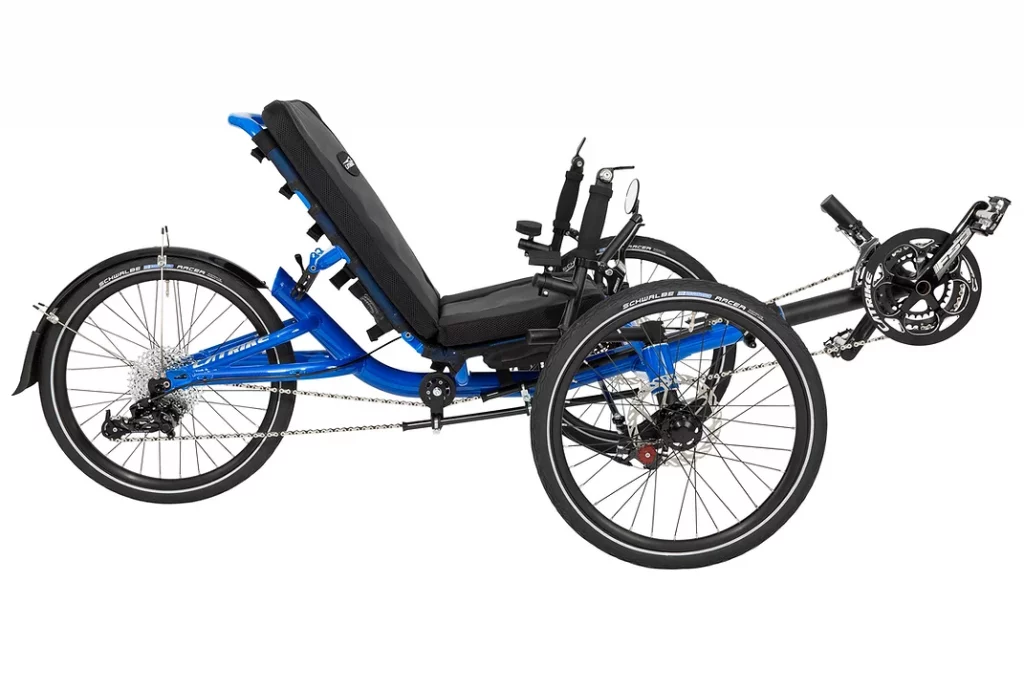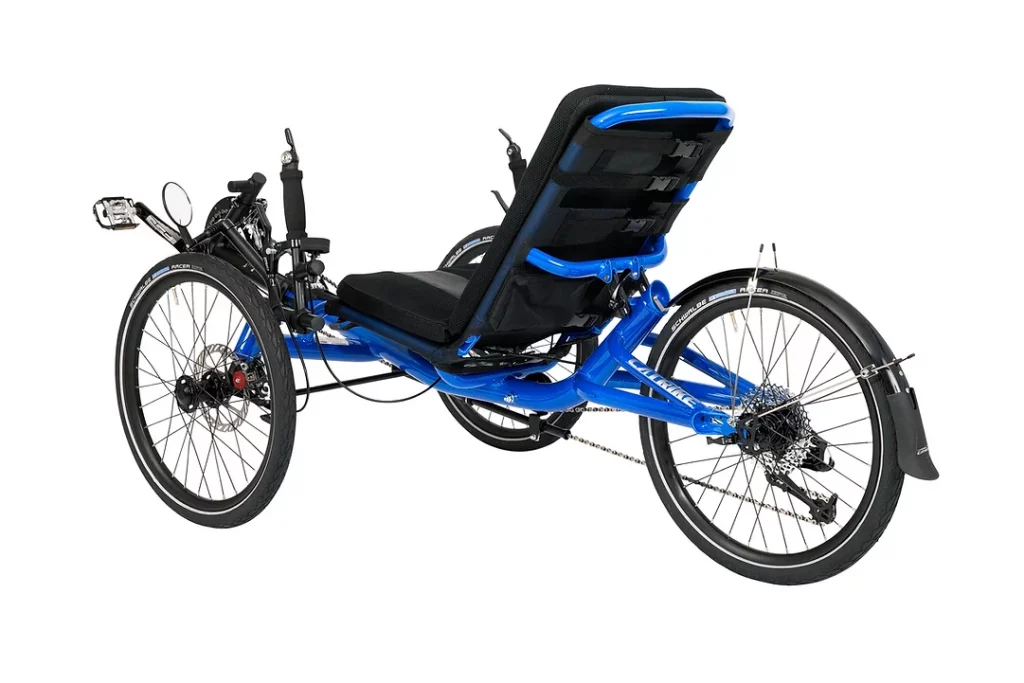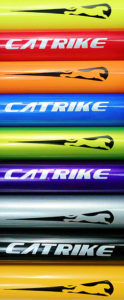Catrike Villager Review

People asked and the Catrike Villager delivered. With the aging populations, people have difficulty getting into and out of other Catrikes because of the low seat heights. Once you sit down on the Catrike Villager, you’ll immediately realize that this trike’s seat height is noticeably higher than either the Catrike Road or the Trail. The Road has your posterior at 8 inches, the Trail is 9.25 inches, and the Villager elevates you to 12.5 inches. You might not think that’s much, but it really makes getting into and out of the trike much easier.
Frame: The frame on the Catrike Villager is aluminum, TIG welded together in Florida. I would have to say the welds are beautiful and of the highest quality in the industry. The frame is constructed out of oversize shaped and manipulated aluminum tubing.
Paint: There is no one in the bike industry that is better, maybe just equal to, their paint jobs. Their standard paint job is everything you want in a paint job; it’s clean, consistent and durable along with seven colors to choose from. Catrikes double coat colors are OMG awesome, and you have five more colors to choose from.
Drive Train: The shifting is superb on the Villager. Catrike choose a premium SRAM drive train combination with ten gears to choose from in the rear and three in the front for a total of thirty. The SRAM GX rear derailleur performed flawless, mating the SRAM GX with the SRAM 500 TT Bar End Shifter and Microshift front derailleur is a combination that Catrike uses quite often.
Brakes: Catrike chose Avid BB7 mechanical disc brakes with Avid Speed Dial brake levers for the Catrike Villager. This combination stopped the trike consistently and had no brake rub. I have no issue with the mechanical brakes that Avid offers; they are simple, reliable and easy to adjust. Super convenient features of the Avid mechanical brakes are that each brake pad can be adjusted independently so you can really dial in your brake adjustment. Catrike chose a simple Velcro strap that you wrap around one of the brake levers for your parking brake. I really like this because it is simple and adds no weight to the trike. This also allowed Catrike to be able to use a premium brake lever. ICE trikes went a different route by adding a brake to the rear wheel and a remote shifter to control the brake. This works well but added almost a pound to the ICE trikes.
Seat: Not only is the seat higher on the Villager, but the angle isn’t as laid-back as I am used to. Again, using those other two trikes as a comparison, the Road has a recline angle of 37 degrees, the Trail is 45. The Catrike Villager seat back angle can be adjusted from 41 degrees to 51 degrees of tilt so you can have the best of both worlds. Perhaps this isn’t as upright as the chair in your dining room, but it sure felt like it! If you have issues with a strained neck, this trike won’t aggravate the condition.
Ride: One thing I do with every trike is to make every effort to find out where that gone-too-far point is. The combination of speed and turning radius that has me holding my breath and wishing I took up knitting instead. Just about any trike can be prodded into lifting a wheel if pushed far enough. The wider you make it and the more reclined you sit, the harder you have to push it in turn to get that wheel to come up. With this seat height of just over a foot, I was concerned about the handling of the Catrike Villager. I didn’t need to be.
Sure, I was able to get the inside wheel to lift – but I had to really crank it hard in a turn, harder than I normally ever would, just to get it to come up even a little. Oh yes, toss in some bumpy downhill turns, have the rider lean to the outside, then we might see more air beneath the wheel – but it’s not something that will happen with normal riding.
In conclusion: I found this trike to be a typical Catrike: lovely paint scheme, flawless welds, no-surprises in handling, and all at a price that must have its competition grumbling. Is it the perfect trike for everyone? Of course not. As much as I liked the trike, it’s not one I would want as my only ride. I like to get more of my body weight on my back and not my butt, for example, so the recline is not what I personally would like for long periods. The seat height is nice; eventually, you begin to not like the squat-and-drop approach to sitting down on most trikes. The performance was better than adequate, though, there are times when I do want to ride faster than was easily done on the Catrike Villager.
If you feel that you are a “casual” rider – whatever that means – if you like the simplicity of no front derailleur, if you are not interested in climbing the steepest hills, nor racing other riders, then this trike may be the “just right” that Goldilocks found.
Best place to buy: Your local Catrike dealer or www.industrialbicycles.com
Pros:
- High seat and adjustable recline
- Great paint and finish
- Light
Cons:
- Increase wind resistance from upright siting
Best Place to Buy:
Your local bike shop or www.industrialbicycles.com



- Height: 12.5″ (318 mm)
- Angle: 47 – 58º
Wheels and Tires
- Front wheel size: 20 x 1.5″
- Rear wheel size: 20 x 1.5″
Measurements
- Max bottom bracket height: 17″ (432 mm)
- Ground clearance: 5.5″ (140 mm)
- Wheelbase: 38″ (965 mm)
- Track width: 31″ (787 mm)
- Total width: 34.5″ (876 mm)
- Max length: 69″ (1753 mm)
- Total height: 28.5″ (724 mm)
- Turning circle: 16′ (4.9 m)
Specifications
- Bottom bracket standard: FSA Gossamer Pro Triple
- Weight: 34 lbs (15.5 kg)
- Max payload: 275 (125 kg)
- Frame material: Heat-treated aluminum
- X-Seam Range: 39 -46″ (990 – 1168 mm)